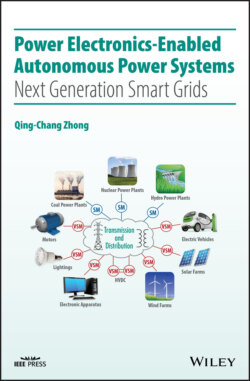Читать книгу Power Electronics-Enabled Autonomous Power Systems - Qing-Chang Zhong - Страница 14
Acknowledgments
ОглавлениеIt is Father's Day as I am writing this. I cannot help but miss my parents, who live 12,000 km away from me. Needless to say, it is they who have planted the seeds for everything in this book. They nurtured me to keep being upright and taught me to serve the society wherever I am. They are like a mountain in my home town, constantly providing me with energy, courage, and calmness. There are many words I can say to thank them but, whatever I say, it is never enough to express my gratitude for what they have given me. There are many things I can do to thank them but, whatever I do, it is never enough to show my appreciation for them. The only thing that makes me feel slightly better is to call them once a week while I keep moving forward every day – I have been doing this for nearly 20 years. Many teachers and professors have taught me with their life‐long experiences, valuable wisdom, and profound knowledge, which have directly contributed to the development of the technologies described in this book. “Teacher for one day, father forever,” as a Chinese proverb says. I will always remember them. This book is dedicated to two of them, my first‐grade teacher Ms. Luo and my third‐grade teacher Ms. Lin for their inspirational words. This book holistically summarizes the intensive and extensive thinking I have had about future power systems since 2001. Over the last 18 years, I have had the great opportunity to advance this line of research with collaborators, postdoctoral researchers, and PhD students, including Mohammad Amin, Frede Blaabjerg, Dushan Boroyevich, Jianyun Chai, Chengxiu Chen, Joseph M. Guerrero, Tomas Hornik, George Konstantopoulos, Miroslav Krstic, Fred Lee, Hong Li, Zijun Lyu, Zhenyu Ma, Wen‐Long Ming, Long Nguyen, Beibei Ren, Tiancong Shao, Wanxing Sheng, Márcio Stefanello, Yeqin Wang, George Weiss, Yu Zeng, Xiaochao Zhang, Yangyang Zhao, Qionglin Zheng, and Yuanfeng Zhou, just to name a few. Their contributions to the work included in this book are greatly appreciated. I would like to thank Royal Academy of Engineering, U.K. and the Leverhulme Trust for the award of a Senior Research Fellowship during 2009–2010. Their visionary decision has made a significant impact on my research in this area. I would also like to thank the Engineering and Physical Sciences Research Council, UK for their support (under Grant No. EP/J01558X/1 and EP/J001333/2), which has facilitated me to make some major breakthroughs in this area. It is a great honor for me to be invested as the Max McGraw Endowed Chair Professor of Energy and Power Engineering and Management at Illinois Institute of Technology. Max McGraw (1883–1964) founded McGraw Electric Company in 1900 when he was 17 years old and acquired Thomas A. Edison, Inc. in 1957 to form the McGraw–Edison Company, which employed 21,000 people in 1985 when acquired by Cooper Industries. He never retired. He was so visionary and established McGraw Foundation in 1948 with the mission to provide financial assistance for educational and charitable purposes in furtherance of the public good and promoting the well‐being of all humanity. He will be remembered forever. The support of our industrial partners and advisors has always been instrumental for our research. I am particularly grateful to Phillip Cartwright and Kevin Daffey (Rolls‐Royce), James Carlson (Carlson Wireless Technologies), Gene Frantz (former Principal Fellow of Texas Instruments), Mark Harral (GroupNire), Aris Karcanias (FTI Consulting), Tony Lakin (Turbo Power Systems), Jim MacInnes (Crystal Mountain), Brian MacCleery (National Instruments), Robert Owen (Texas Instruments), and Zhenyu Yu (Texas Instruments). It has been a great pleasure to work with the colleagues of John Wiley & Sons, Ltd and IEEE Press. The support and help from Steven Fassioms (the Project Editor), Michelle Dunckley (the Editorial Assistant), Karthika Sridharan (the Production Editor), and Sandra Grayson (the Commissioning Editor) are greatly appreciated. The visionary decision of Peter Mitchell in signing the contract for publishing this book should be acknowledged as well. I would also like to thank the readers of this book in advance. I believe the SYNDEM grid architecture together with the underpinning technologies will play a key role in making power systems worldwide stable, reliable, sustainable, secure, and resilient. We need your help, support, and dedication. Spread the word and save the planet! I would like to thank my wife Shuhong Yu for her support, patience, love, and sacrifice. She has taken over all the responsibilities in taking care of the family, which has allowed me to focus on thinking and research. I would also like to thank my wonderful daughters Rui and Lisa for being supportive, considerate, active, and forward‐looking. Last but not least, I would also like to take this opportunity to thank those I have not mentioned above but have had a direct or indirect impact on me or my research, good or bad. You have made me better and stronger.
Thank you all!
Qing‐Chang Zhong
zhongqc@ieee.org
IEEE Fellow, IET Fellow
Founder & CEO, Syndem LLC
Chicago, USA
http://www.syndem.com
Max McGraw Endowed Chair Professor in Energy and Power Engineering
Department of Electrical and Computer Engineering
Illinois Institute of Technology
10 W 35th Street
Chicago, USA
http://peac.ece.iit.edu/
16 June 2019
